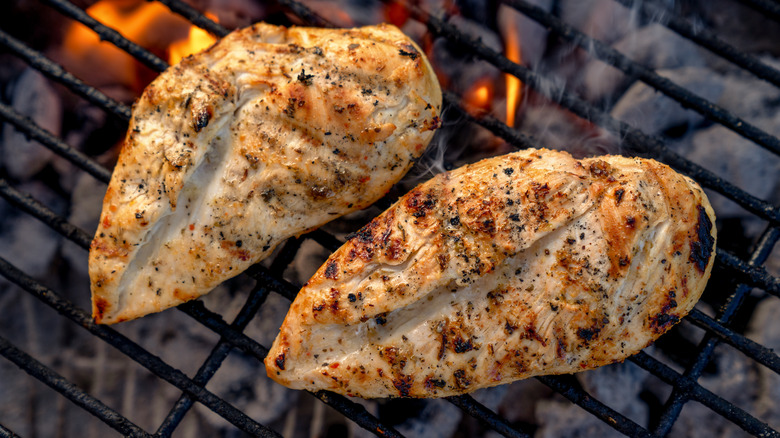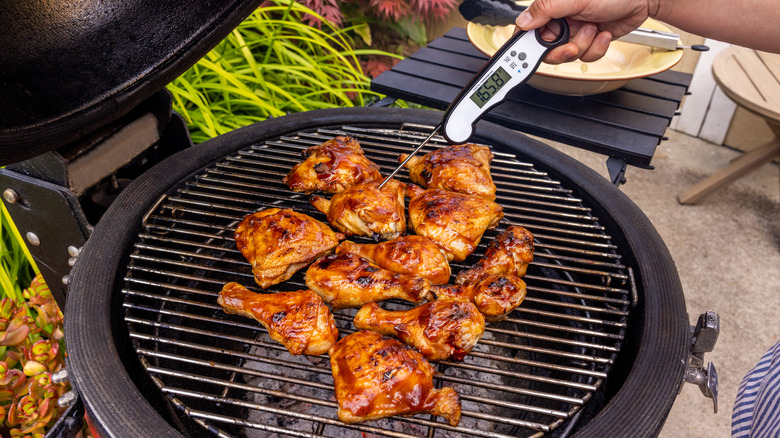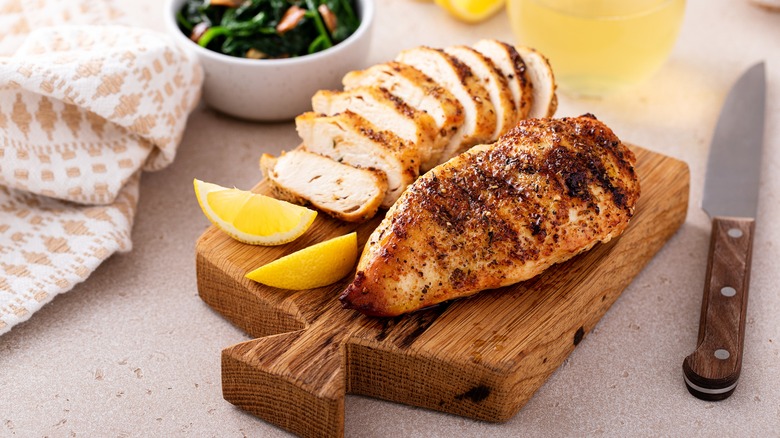The One Thing You Should Never Do When Grilling Chicken
When temperatures begin to climb and outdoor cooking and dining return to the menu, it's time to fire up the grill. But don't be scared — even if you've never touched a grill before, it's hard to mess up a grilled lemongrass chicken or grilled tandoori chicken, maybe even with a side of delicious grilled vegetables.
The main thing any novice grillmaster should know is that it's imperative to not leave the grill lid open when making your chicken. In order for it to turn out tender and juicy (instead of blackened to a crisp and half raw in the middle), you need to create an enclosed space. Trapping the heat from the grill and creating a temperature-controlled area will cook your chicken from all sides. (Just make sure to flip the meat halfway through.)
You can cook at lower temperatures using this method because the grill will create convection and retain heat, as well as allow the juices from the chicken to, effectively, steam it. This will also cause your chicken to cook much faster, saving time and energy while allowing you to get dinner on the table before the kids start a picnic table mutiny. For extra finesse, opt for a 'reverse sear' ... but more on that later.
Thick cuts of chicken need a closed lid
Opening your grill lid throughout the cooking process can dry out your meat, thanks to the increased fluctuation in temperature. And exposure to the open air can cause drafts to blow fat drippings from your meat into the flames, which can induce your grill to flare and potentially overcook your meat. This can also be a safety issue — flares can be dangerous and cause an abundance of smoke, and you're probably not trying to give your next-door neighbors an asthma attack.
Maintaining proper grill procedure is especially important when cooking thick or uneven pieces of meat, like chicken breasts. While thinner meats and veggies will cook whether the grill lid is open or closed, thicker cuts need a more consistent heat flow to cook all the way through. (After all, imagine you were roasting chicken in the oven — you wouldn't want to open the door every five minutes and let the heat out!)
The rule of thumb is to close your lid for cuts of meat thicker than three-quarters of an inch. But if you've got a cutlet that has a thick center but is thinner on the sides, giving it a thorough pounding will help even out the situation and make it easier to cook. You could even flatten your chicken out panini-style with a pre-heated cast iron grill press.
How long to grill chicken
When grilling chicken, there are a few other things you might want to keep in mind to produce the juiciest, most delicious results. Chicken cuts with the bone in will need longer to cook, about half an hour for drumsticks, and up to 40 minutes for bone-in chicken thighs. Boneless thighs, on the other hand, only need about seven minutes per side, and boneless breasts should be cooked for six minutes on each side. Chicken wings fall in the middle, needing about 20 minutes of grill time.
You'll also want to know where your direct and indirect heat sources are. Direct heat zones, aka the places right above the fire, can be used for chicken wings or pounded breasts. Larger pieces of chicken should be cooked with the lid closed, on indirect heat zones, to avoid burning, and then finished with the lid open on direct zones. This is known as a 'reverse sear' since the traditional way to cook chicken breasts on the stovetop is to sear them first on high heat, uncovered, and then allow them to cook, covered, on low heat. In all, two different methods for the same perfect, crispy finish.



